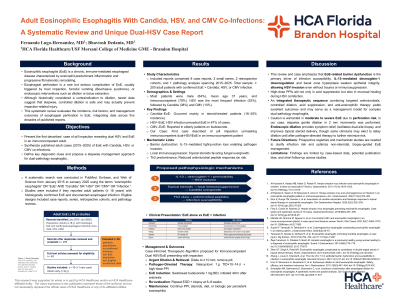Sunday Poster Session
Category: Esophagus
P0595 - Adult Eosinophilic Esophagitis With Candida, HSV, and CMV Co‑Infections: A Systematic Review and Unique Dual‑HSV Case Report
Sunday, October 26, 2025
3:30 PM - 7:00 PM PDT
Location: Exhibit Hall

Has Audio

Fernando Lugo-Hernandez, MD
HCA Florida Healthcare
Brandon, FL
Presenting Author(s)
Fernando Lugo-Hernandez, MD, Bhavtosh Dedania, MD
HCA Florida Healthcare, Brandon, FL
Introduction: Eosinophilic esophagitis (EoE) is a chronic, immune-mediated disease defined by ≥15 eosinophils per high-power field and driven by Th2 inflammation. While Candida, HSV, and CMV esophagitis are typically seen in immunocompromised hosts, emerging evidence suggests these infections may also affect immunocompetent adults with EoE due to epithelial barrier dysfunction and localized immunosuppression from swallowed steroids. To better characterize this overlap, we performed a systematic review of adult EoE cases with confirmed Candida, HSV, or CMV co-infection and present a rare case of dual HSV/EoE in an immunocompetent patient.
Methods: We searched PubMed, Embase, and Web of Science (Jan 2015–Jan 2025) following PRISMA guidelines. Inclusion criteria were adult patients with histologically confirmed EoE and concurrent esophageal infection. Two reviewers independently screened studies, assessed quality using Newcastle–Ottawa and JBI tools, and extracted data on demographics, infection type, histology, treatment, and outcomes. Pooled estimates and narrative synthesis were performed.
Results: Of 312 records, 13 met inclusion (12 prior cases and 1 new). Candida was most common among patients on topical steroids (16%, 95% CI 11.6–21.7%). HSV esophagitis preceded EoE in 67% of cases (95% CI 43.7–83.7%), while CMV was rare, mainly in elderly patients on budesonide. Histology revealed eosinophilic inflammation alongside fungal hyphae or viral inclusions. Our case involved a 40-year-old immunocompetent male with potassium pill impaction. Endoscopy showed severe stricture, 37–55 eos/hpf, and acute ulcerative HSV esophagitis. He improved with high-dose PPI and valacyclovir.
Discussion: This review highlights that infectious esophagitis and EoE are not mutually exclusive, even in immunocompetent adults. Disruption of epithelial barriers by Th2 inflammation, downregulation of junctional proteins (e.g., desmoglein-1 via IL-13), and local immunosuppression from topical steroids may predispose to Candida, HSV, or CMV superinfection. In our case, pill impaction revealed underlying dual pathology. Across cases, dual-site biopsies—sampling both ulcerated and intact mucosa—were critical for diagnosis. A coordinated strategy including antimicrobials, acid suppression, cautious dilation, and delayed steroid initiation is key to optimizing outcomes and avoiding complications in dual-pathology esophagitis.
Disclosures:
Fernando Lugo-Hernandez, MD, Bhavtosh Dedania, MD. P0595 - Adult Eosinophilic Esophagitis With <i>Candida</i>, HSV, and CMV Co‑Infections: A Systematic Review and Unique Dual‑HSV Case Report, ACG 2025 Annual Scientific Meeting Abstracts. Phoenix, AZ: American College of Gastroenterology.
HCA Florida Healthcare, Brandon, FL
Introduction: Eosinophilic esophagitis (EoE) is a chronic, immune-mediated disease defined by ≥15 eosinophils per high-power field and driven by Th2 inflammation. While Candida, HSV, and CMV esophagitis are typically seen in immunocompromised hosts, emerging evidence suggests these infections may also affect immunocompetent adults with EoE due to epithelial barrier dysfunction and localized immunosuppression from swallowed steroids. To better characterize this overlap, we performed a systematic review of adult EoE cases with confirmed Candida, HSV, or CMV co-infection and present a rare case of dual HSV/EoE in an immunocompetent patient.
Methods: We searched PubMed, Embase, and Web of Science (Jan 2015–Jan 2025) following PRISMA guidelines. Inclusion criteria were adult patients with histologically confirmed EoE and concurrent esophageal infection. Two reviewers independently screened studies, assessed quality using Newcastle–Ottawa and JBI tools, and extracted data on demographics, infection type, histology, treatment, and outcomes. Pooled estimates and narrative synthesis were performed.
Results: Of 312 records, 13 met inclusion (12 prior cases and 1 new). Candida was most common among patients on topical steroids (16%, 95% CI 11.6–21.7%). HSV esophagitis preceded EoE in 67% of cases (95% CI 43.7–83.7%), while CMV was rare, mainly in elderly patients on budesonide. Histology revealed eosinophilic inflammation alongside fungal hyphae or viral inclusions. Our case involved a 40-year-old immunocompetent male with potassium pill impaction. Endoscopy showed severe stricture, 37–55 eos/hpf, and acute ulcerative HSV esophagitis. He improved with high-dose PPI and valacyclovir.
Discussion: This review highlights that infectious esophagitis and EoE are not mutually exclusive, even in immunocompetent adults. Disruption of epithelial barriers by Th2 inflammation, downregulation of junctional proteins (e.g., desmoglein-1 via IL-13), and local immunosuppression from topical steroids may predispose to Candida, HSV, or CMV superinfection. In our case, pill impaction revealed underlying dual pathology. Across cases, dual-site biopsies—sampling both ulcerated and intact mucosa—were critical for diagnosis. A coordinated strategy including antimicrobials, acid suppression, cautious dilation, and delayed steroid initiation is key to optimizing outcomes and avoiding complications in dual-pathology esophagitis.
Disclosures:
Fernando Lugo-Hernandez indicated no relevant financial relationships.
Bhavtosh Dedania indicated no relevant financial relationships.
Fernando Lugo-Hernandez, MD, Bhavtosh Dedania, MD. P0595 - Adult Eosinophilic Esophagitis With <i>Candida</i>, HSV, and CMV Co‑Infections: A Systematic Review and Unique Dual‑HSV Case Report, ACG 2025 Annual Scientific Meeting Abstracts. Phoenix, AZ: American College of Gastroenterology.
